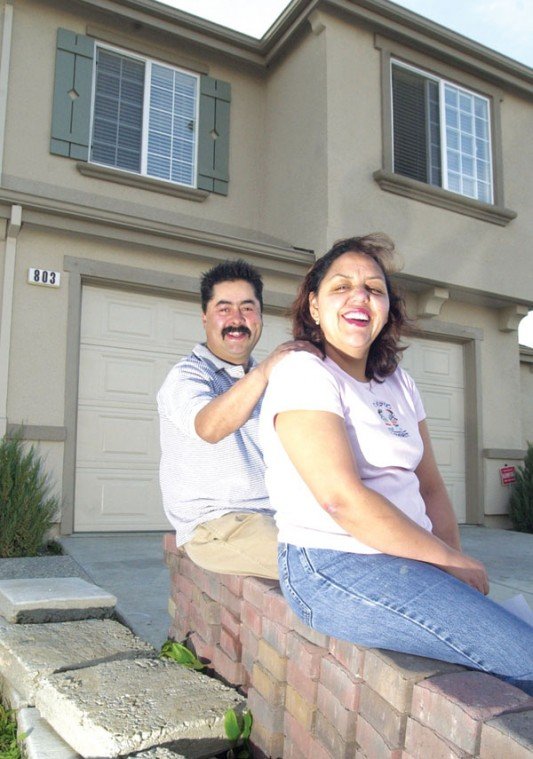The word
”
developer
”
has many connotations these days.
Depending on which side of the growth debate you side with, the
word may symbolize a self-interested profiteer paving over the
greenery of this once lush agricultural valley.
The word “developer” has many connotations these days.
Depending on which side of the growth debate you side with, the word may symbolize a self-interested profiteer paving over the greenery of this once lush agricultural valley.
Or, the word may represent a visionary landowner who sees a barren nothing and then creates architectural grandeur.
Over the last quarter century, however, a different type of developer has emerged across four Central Coast counties. As South County Housing celebrates its 25th year of existence, the non-profit developer of affordable housing is gaining national recognition for neither hackneyed archetype.
From building a 14-unit apartment complex from nothing in 1982 to converting an old hospital into a 110-unit senior housing complex 10 years ago, the Gilroy-based company has helped thousands families experience a key part of the American dream – finding a safe, comfortable and affordable place to live.
Across Monterey, Santa Cruz, San Benito and Santa Clara counties, 63 high-quality, affordable-living homes – from apartments to houses – are either built, being built or planned for construction. That averages two and a half housing projects a year, some of them involving 1,600-square-foot single-family homes.
“I never envisioned South County Housing would grow and have such an impact on so many people,” said Barbara Mendoza, one of 16 founders of South County Housing. “But we still need 30 more organizations just like it.”
Mendoza, who still serves as a director on the organization’s board, recalls the days before South County Housing formally organized. As the small group of activists began to form, it lobbied public officials to improve the housing situation many county residents, especially farm workers, were facing.
“There were families with roofs over their head, but they lived on dirt floors,” Mendoza said. “The homes had no foundation.”
The effort came with an ironic price. The government didn’t have funding or programs available to improve living quarters, but it had the mandate to evict people living in substandard homes, Mendoza said.
After the harsh realities of economics and bureaucracy became apparent, a former Gavilan College president, the late Rudy Melone, stepped in, Mendoza recalled.
In late 1979, Melone called together a small group of local movers and shakers who shared concerns over housing issues. They decided to form a non-profit corporation that could lobby for funding and use it to build the homes themselves.
Today, South County Housing employs 80 people across five departments, functions as general contractor over many of its projects and is property manager for its multi-family housing facilities.
Executive Director Dennis Lalor is proud of South County Housing’s development accomplishments, especially when considering the company employed six people when he took over in 1987. But Lalor’s face and voice really light up when he talks about the people whose lives have been, almost miraculously, turned around through the help of those workers.
In the late ’80s, Josie Ramirez was a recently divorced mother of three children struggling to meet high Silicon Valley rents before she heard about South County Housing.
In 1990, Ramirez saw an ad for a loan packager with the organization. She applied and won the job, getting promoted to property manager in 1993 and a department manager in 2000.
Ramirez also is a resident property manager to receive a reduced rent, making it easier to cover the costs of living that would be absorbed by a couple’s second income.
With a growing knowledge of first-time home buyer programs due to her work with South County Housing, Ramirez saved her money and later was able to buy her first home in San Benito County. The economy boomed, her equity grew and she purchased another home in San Jose.
Ramirez now owns three homes, renting two out for additional income.
“The timing was right,” Ramirez said. “God was with me.”
Ramirez now works as a home loan sales manager for a separate company but thinks back fondly on her experience with South County Housing.
“I experienced on a micro level what they do on a macro level for people every day,” Ramirez said. “They help people realize their dreams not by giving them something but by providing opportunities to take control of their lives. They’re not really giving anything away, they’re helping you with guidance and expertise.”
Ramirez’s point is perhaps best proven by a new style of development South County Housing is embracing in these post dot-com, harsh economic times.
In 1999, South County Housing developed a unique project in the northwest quad of Gilroy called Los Arroyos. Los Arroyos featured 230 dwelling units, from senior rentals to single-family houses, but with two interesting and groundbreaking catches.
Because government funds were not plentiful, South County Housing built some homes to be sold at market-rate levels. They used profits from those sales to develop the affordable units and houses.
To make some of the homes affordable, they saved on labor costs by letting families help build the houses themselves, putting the sweat in sweat-equity.
“It’s amazing how this system is starting to catch on around the country,” Lalor said. “It’s the way of the future.”
The Basurto family is one of the program’s beneficiaries. But it almost wasn’t. On a low-income apartment waiting list for 10 years and the Los Arroyos list for five, the Basurtos were ready to leave Gilroy.
“We were going to move to Monteca. I already asked for a work transfer, and then all of a sudden we got a letter saying we got in (to Los Arroyos),” Olga Basurto said. “We couldn’t afford to stay in Gilroy if it wasn’t for South County Housing. My kids were so happy because they were going to miss their friends.”
For every happy homeowner in a South County Housing project, there are even more renters who have found happiness.
Maria Robles is one of them.
Robles was one of the original people to benefit from South County Housing’s first-ever project, a 14-unit apartment complex off Eigleberry Street called The Trees.
Robles and her late husband lived in Hermosillo, Mexico, and would visit family she had in Gilroy. Eventually, they found work in the fields and at the downtown cannery – a site South County Housing hopes to buy next month.
In 1982, Robles moved into The Trees in the ground floor apartment where she still resides and tends to her small patio garden.
“Without this apartment, I would have kept living with my sister. We could not have gotten our own house, everything was too expensive,” Robles said. “I consider it like my own little house because I’ve been here more than 20 years. I care a lot about it. I don’t want to leave it. I’m very accustomed to it. When I die, I will still be living in this apartment. ”













